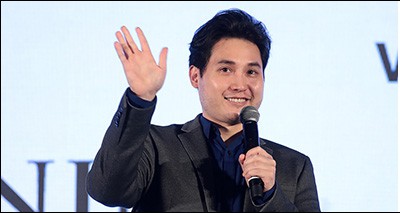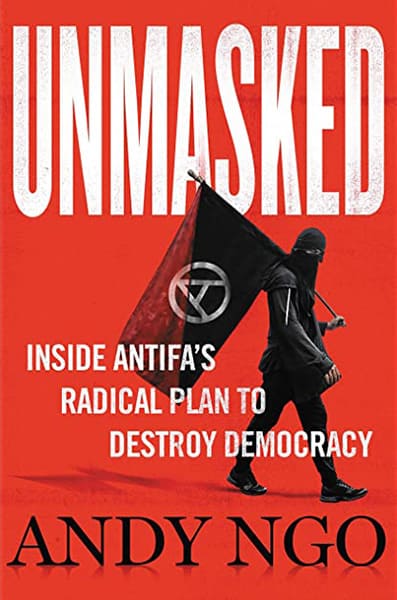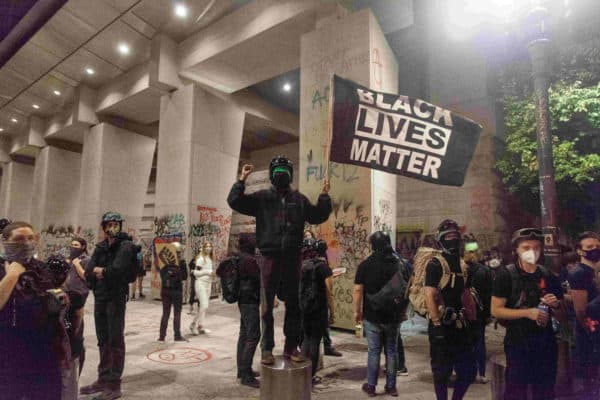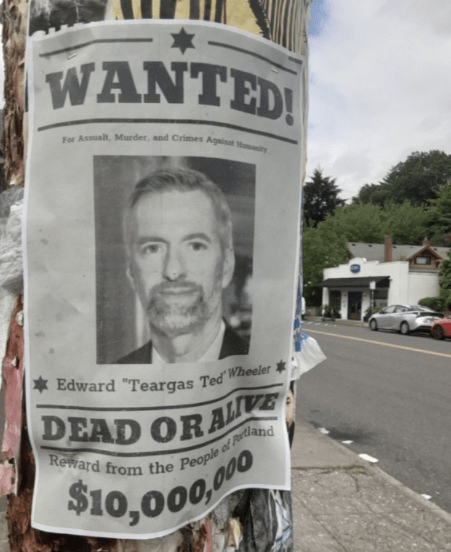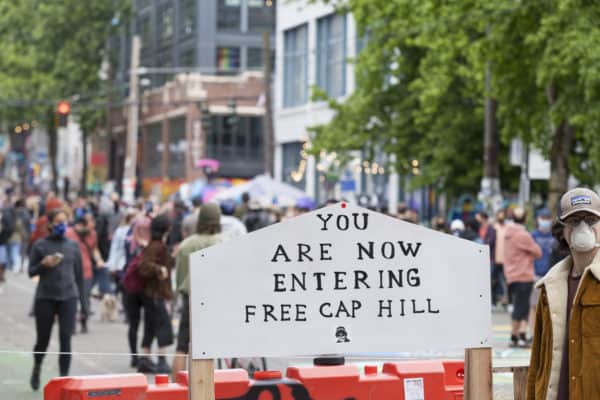Andy Ngo (Credit Image: Gage Skidmore via Wikimedia)
Andy Ngo, Unmasked: Inside Antifa’s Radical Plan to Destroy Democracy, 2021, Center Street, 320 pp. $20.99 (hardcover)
Journalist Andy Ngo has written a book on Antifa, the left-wing extremists known for rioting and attacks on nationalists and conservatives — including Mr. Ngo.
Antifa originated in Germany in 1932 under the name Antifaschistische Aktion (Antifascist Action), and used a two-flags logo very similar to the one it still uses today. Founded by members of the German Communist Party and other leftist groups, it fought both the National Socialists and the Social Democrats, the largest left-leaning party at the time. Like today’s version, its concept of “fascism” was broad; it sometimes called Social Democrats “social fascists.”
Antifa continues to use violence: beatings, explosives, arson, and even murder. On June 29, 2019, an Antifa mob beat Mr. Ngo so badly he got a serious head injury that affected his vision, memory, and balance, but it inspired him to investigate the group.
Antifa’s ideology is close to that of Black Lives Matter. BLM was founded by Patrisse Cullors, Alicia Garza, and Opal Tometi in 2013 after George Zimmerman was acquitted in the Trayvon Martin case. Miss Cullors explained in an April 2019 article for the Harvard Law Review that she would like to abolish police, prisons, and the borders of the United States. She also says she and Miss Garza are “trained Marxists.” BLM is part of the Movement for Black Lives, a coalition that wants to “overturn U.S. imperialism, capitalism, and white supremacy.”
Antifa has been in the US since the late 1980s, but came to prominence only in 2016, when it began to work with BLM, acting as security at its events and winning the praise of prominent BLM activist Shaun King. The Washington, DC chapter of BLM promoted an Antifa event in 2017 and has condemned the “dangerous false right-wing narrative about Portland Antifa and Antifa in general.”
Mr. Ngo argues that Antifa gained respectability because BLM is so popular, but the two are not identical: Antifa calls for anarchy and BLM doesn’t. However, In Portland and Seattle, BLM and Antifa are essentially one group, with “the same people showing up to each other’s events.”
July 19, 2020,: A protester holds up a Black Lives Matter sign in front of the Federal Courthouse in Portland, Oregon during another night of protests in the city. (Credit Image: © Leslie Spurlock / ZUMA Wire)
As Mr. Ngo explains, Antifa violence is meant both to intimidate and provoke reactions. Many Antifa activists and sympathetic journalists carry cameras or phones at demonstrations, but are careful not to film Antifa. This minimizes incriminating evidence against them, and by recording only the police reaction it makes police look like aggressors.
Antifa holds secret meetings, often at bookstores and community centers, where it trains members in violence. Journalists from Project Veritas infiltrated Rose City Antifa, a major Portland-area cell, in 2017. Undercover video shows an instructor telling members to “practice things like an eye gouge” because “it takes very little pressure to injure someone’s eyes.” Veritas also infiltrated a Brooklyn Antifa group called The Base, named after al-Qaeda (“the base” in Arabic). There, an instructor recommended breaking ribs: “One good body shot could potentially give you all the time in the world to run away while they’re doubled over in pain, or really put a beating on them after that if you really don’t like the person.”
Mr. Ngo argues that Antifa’s non-violent tactics have been more successful. He covers doxing, a term that comes from “dox,” or “documents” — publishing identifying information such as name, phone number, and home address. Doxing can also identify a victim’s family and friends, and opens them to abuse.
As Mr. Ngo explains, “Antifa want their targets to fear living a normal life,” and this can be done without breaking laws. If someone spots an enemy in public, Antifa uses social media “cyberswarming” to gather a hostile mob. Antifa also like to make death threats. When Mr. Ngo reported threats to the police, they told him they were not crimes if they were not specific. Another tactic is to print “wanted” posters of an enemy and post them in his neighborhood.
Credit Image: Screenshot via Andy Ngo’s Twitter
On Halloween night 2019, a group showed up at Mr. Ngo’s house, rang the bell persistently and then began banging on the door. There were six people, dressed in black, all wearing paper printouts of his face as masks. He called the police, but notes that “they likely didn’t even break any law.”
Antifa work hard at propaganda. Mr. Ngo believes most liberal journalists have no idea how extreme the group is, but some who know still praise the group. This includes former NPR contributor and current Teen Vogue writer Kim Kelly, who promotes “Nazi hunting,” and Portland Mercury news editor Alex Zielinski. Miss Zielinski tweeted out Ngo’s location at a rally, after which a mob flashed powerful lasers at his eyes.
Andrew Gittlitz is a journalist caught on video at an Antifa combat training session. He has written for VICE, Salon, and the New York Times under the name A. M. Gittlitz.
One Antifa tactic is unpersoning: demonizing a target and pressuring others to cut ties with him. Antifa often claim that Mr. Ngo incites violence. Portland-area activist Gregory McKelvy claims Mr. Ngo supplies “kill lists” of Antifa members to neo-Nazis.
Mr. Ngo argues that if Antifa took power, we would get a regime like that of the East German communists. It called Western democracy “fascist” — the Berlin Wall was the “anti-fascist barrier” — and suppressed dissent. It used more than 600,000 informants and put secret cameras and microphones in targets’ homes.
The CHAZ (Capitol Hill Autonomous Zone) says something about the nature of Antifa. For three weeks in the summer of 2020, Antifa and other far-left groups took over part of Seattle and kept the police out. They set up border walls, defended them with armed guards, and stopped vehicles from entering or leaving.
A handmade sign marks the start of the “Capitol Hill Autonomous Zone” in Seattle on Friday, June 12, 2020. The zone, also known as CHAZ, is a self-declared intentional community and commune established when the Seattle Police Department closed the East Precinct after days of large protests and occasional violent clashes. (Credit Image: © Paul Christian Gordon / ZUMA Wire)
The radicals lived on donated food from the outside; the city even provided porta-potties and wash stations. There were gardens, but “most of the plants had wilted within a day or two.” Despite much talk of “anti-racism,” the gardens were racially segregated, with a separate area for “black and indigenous folk.” Most of the CHAZ was also segregated.
Militants served as security but failed to stop violence. It took two homicides, including one of a black teenager, for the city to take back the autonomous zone.
Mr. Ngo writes that his parents suffered under Vietnam’s communist government. Conditions were so bad that many Vietnamese — including his parents — fled the country. The UN High Commission on Refugees estimates that up to 400,000 died escaping from Indochina by sea, and that over 800,000 Vietnamese lived in refugee camps in Southeast Asia and Hong Kong.
As a child of foreigners, Mr. Ngo finds that many Americans take their own peace and freedom for granted. Many don’t realize that in America “conflicts are supposed to be solved through dialogue and mediation,” but in much of the world, the first resort is to “tribal warfare and vigilantism.” He writes that in more than a third of the world, people are routinely “denied basic civil and political rights.” Antifa value none of these things and instead call our system “fascist” and “racist.”
Who joins Antifa? Mr. Ngo has analyzed records of almost 1,000 people arrested for rioting with Antifa and notes that most are not well-off. While “some are indeed highly educated and in white-collar professions ranging from law to academia to health care,” many are poor, homeless, or mentally ill.
Deidra Rose Watts, 25, formerly known as David Villalpando Perez, of Vancouver, Wash., was arrested at the antifa gathering in north Portland. She’s part of the #antifa press crew & was quickly released without bail. #PortlandRiotshttps://t.co/9kkSQGeMkZhttps://t.co/Bw2AvOHyK9pic.twitter.com/9tAp4wfpos
— Andy Ngô (@MrAndyNgo) September 7, 2020
Antifa often operate with impunity because the authorities look the other way, but enforcing existing law could stop them. The RICO (Racketeering Influenced and Corrupt Organizations) Act could take down both street thugs and organizers. Mr. Ngo argues that because district attorneys are politicians, they bend to pressure and refuse to prosecute. Multnomah County DA Mike Schmidt refused to prosecute more than 90 percent of those arrested for rioting in Portland. Mr. Ngo wants “independent oversight to hold rogue prosecutors accountable.”
Mr. Ngo is suing Rose City Antifa, a Portland-area cell that repeatedly attacked him. Although Portland police did nothing when he reported the attacks, he got the real names of five suspects and has charged them and 50 anonymous Antifa with assault, battery, intentional infliction of emotional distress, and RICO violations.
Antifa tried to stop publication of this book. The largest bookstore in Portland, Powell’s Books, bowed to pressure and took it off the shelves but refused to remove it from its online catalog. Mr. Ngo suggests that the resulting publicity has only increased demand, and his publisher had to rush more printings. The book is still available online and is doing very well at Amazon. On February 2, the day it was released, it was the #1 bestseller in Political Commentary & Opinion, Radical Political Thought, and Local U.S Politics.
Once when he tried to film Antifa at a Seattle rally, a mob surrounded him. One Antifa said, “Some of us didn’t really come to talk. Some of us came to die, dude. Are you willing to die for YouTube shit?” Mr. Ngo is not willing to die for “YouTube shit,” but is certainly willing to fight for his country.
